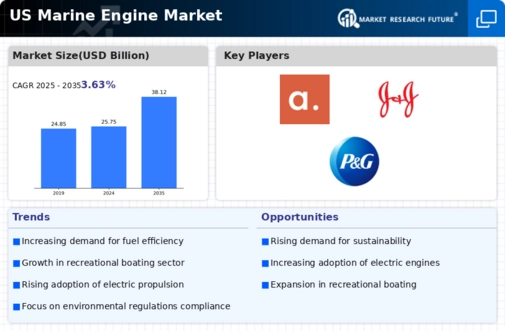Advancements in Engine Efficiency
The marine engine market is significantly impacted by advancements in engine efficiency, which are becoming increasingly critical in the face of rising fuel costs and environmental concerns. Engine manufacturers are investing in research and development to create engines that consume less fuel while delivering higher performance. For instance, the introduction of hybrid and electric marine engines is gaining traction, as they offer reduced emissions and lower operational costs. Data indicates that fuel-efficient engines can reduce operating costs by up to 30%, making them attractive to both commercial and recreational users. This focus on efficiency not only enhances the appeal of marine engines but also aligns with broader sustainability goals within the industry. As a result, the marine engine market is likely to shift towards more efficient technologies, reshaping consumer preferences and purchasing decisions..
Rising Demand for Recreational Boating
The marine engine market is experiencing a notable increase in demand for recreational boating activities across the United States. This trend is driven by a growing interest in outdoor leisure activities, with many individuals seeking to invest in personal watercraft and boats. According to recent data, the recreational boating sector has seen a growth rate of approximately 5% annually, which directly influences the marine engine market. As more consumers purchase boats, the need for efficient and reliable marine engines becomes paramount. This rising demand not only boosts sales for engine manufacturers but also encourages innovation in engine technology, as companies strive to meet consumer expectations for performance and sustainability. Consequently, the marine engine market is likely to benefit from this trend, as manufacturers adapt to the evolving preferences of recreational boaters.
Growth in Commercial Shipping Activities
the marine engine market is set to grow due to the expansion of commercial shipping activities in the United States.. As global trade continues to increase, the demand for efficient and reliable marine engines for cargo vessels is on the rise. Recent statistics suggest that the U.S. shipping industry contributes over $150 billion to the economy, highlighting the importance of marine engines in facilitating trade. This growth in commercial shipping not only drives demand for new engines but also necessitates upgrades to existing fleets to comply with evolving regulations and efficiency standards. Consequently, manufacturers in the marine engine market are likely to experience increased orders and investments as shipping companies seek to enhance their operational capabilities. This trend underscores the critical role that marine engines play in supporting the broader logistics and transportation sectors.
Increased Focus on Environmental Regulations
the marine engine market is greatly influenced by the increasing focus on environmental regulations aimed at reducing emissions and promoting sustainability.. Regulatory bodies in the United States are implementing stricter standards for marine engines, compelling manufacturers to innovate and comply with these requirements. For instance, the EPA has introduced regulations that limit nitrogen oxides (NOx) and particulate matter emissions from marine engines. This regulatory environment is driving the development of cleaner technologies, such as low-emission engines and alternative fuel options. As a result, manufacturers are investing in research to create engines that not only meet regulatory standards but also appeal to environmentally conscious consumers. This heightened focus on compliance and sustainability is likely to propel the marine engine market forward, as companies adapt to the changing landscape and seek to differentiate themselves through eco-friendly innovations.
Technological Integration in Marine Operations
The marine engine market is increasingly influenced by the integration of advanced technologies in marine operations. Innovations such as IoT (Internet of Things) and AI (Artificial Intelligence) are being adopted to enhance engine performance and operational efficiency. For example, smart engines equipped with sensors can provide real-time data on performance metrics, allowing for predictive maintenance and reducing downtime. This technological integration not only improves the reliability of marine engines but also appeals to operators looking to optimize their fleets. As the industry moves towards more connected and automated systems, the marine engine market is likely to see a surge in demand for engines that can seamlessly integrate with these technologies. This trend may lead to a more competitive landscape, as manufacturers strive to offer cutting-edge solutions that meet the evolving needs of marine operators.














Leave a Comment